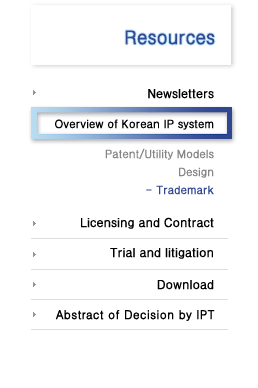|
|
|
|
 |
|
 |
|
HOME > Resources >
Overview of Korean IP
system / Trademark |
| |
| |
|
Procedures for Registering a Trademark |
|
Overview |
|
Trademarks and Service marks (hereinafter referred to as “Trademark”) may be protected in the Republic of Korea under the Korean Trademark Act; and for such protection, marks should be registered with the Korean Intellectual Property Office ("KIPO"). The use of a trademark is not a prerequisite for filing an application for the registration of a trademark. Unregistered marks are not protected under the Trademark Act, although the owner of a well-known or famous mark is given some protection under the Trademark Act by way of preventing others from obtaining a trademark registration for an identical or similar mark. There is no course of action against infringement of a well-known or famous unregistered trademark under the Trademark Act, but an action may be brought under the Unfair Competition Prevention Act.
The Korean Trademark Act is characterized by :
ⅰ) First-to-File Rule
ⅱ) Substantial Examination
ⅲ) Pre-grant Opposition
|
| |
|
Filing an Application
|
|
ⅰ) Documents Required
(a) the registered name, address and nationality of the applicant;
(b) a copy of trademark specimen (black & white or color);
(c) a list of the goods/services to be designated;
(d) a certified copy of the priority document, if priority is to be claimed;
(e) a certified copy of foreign application if priority is claimed;
(f) priority claiming data, if priority is to be claimed; and
(g) a power of attorney, if necessary.
If the applicant fails to submit specimens of the trademark or a power of attorney at the time of filing the trademark application, KIPO will issue a notice of amendment requesting the applicant to submit them, designating a time limit therefor. The priority document must be submitted within 3 months from the filing date in the Republic of Korea of the trademark application. This time limit cannot be extended.
ii) Designation of Goods/Services: NICE Classification
A person who desires to file a trademark application for registration must designate goods/services on which the trademark is to be used in accordance with the NICE Classification of Goods and Services for the Purpose of Registration of Marks.
iii) Claim of Priority
The right of priority can be claimed in a trademark application for an applicant whose country of origin is a party to the Paris Convention or under a bilateral agreement between two relevant governments or on a reciprocal basis. In order to enjoy the priority right, an application should be filed in the Republic of Korea within 6 months from the filing date of the priority application. The priority document should be submitted to KIPO within 3 months from the filing date of its application.
|
| |
|
Examination
Procedures |
|
The Examiner at the KIPO examines whether the application satisfies the criteria of registrability; namely, for distinctiveness of the trademark and similarity of the mark to any prior-registered trademarks designating the same category of goods, and whether the goods have been specified sufficiently.
If the Examiner is not persuaded by the response, he/she will issue a Final Rejection. IN order to challenge the Examiner’s decision, it is possible to file an appeal against the final rejection. Since an appeal is examined by a group of several examiners, a more objective decision can be expected.
|
|
| |
|
publication for
Opposition |
|
If the trademark application satisfies the requirements for registration, the Examiner will issue a Decision for Publication notifying the applicant that the application will be published for opposition purposes, and the application will then be published in the Official Trademark Gazette. Once the trademark application has been published, anyone may file an opposition against the application within two (2) months from the publication date.
|
| |
|
Opposition Procedure |
|
If an Opposition is brought against the published trademark application, the Examiner will conduct the Opposition, and will render a decision based upon the evidence and arguments submitted by the opposer and the applicant. If the opposition is decided as not being reasonable, the Examiner will dismiss the opposition and issue a Decision for Registration, but if the Opposition is reasonable the Examiner will accept the opposition and will issue a Final Rejection against the application. No appeal is available against an opposition decision, although the applicant may lodge an appeal against a final rejection of the application, and an unsuccessful opposer may lodge an invalidation or cancellation trial against the trademark registration. |
| |
|
Grant and
Registration |
|
If the published trademark application encounters no opposition, or if the opposition proceeding is decided in favor of the applicant, the Examiner will issue a Decision for Registration allowing the application for registration. The applicant must then pay the necessary registration fee to the KIPO within two (2) months. It is possible, when paying the registration fee, to delete designated goods/services (typically done to reduce costs). Upon payment of the registration fee, the mark is registered by the KIPO to establish the trademark right and a Certificate of Trademark Registration is issued to the registrant.
|
| |
|
Others |
|
The duration of the protection of a trademark right is 10 years from the date of registration of the trademark, which may be renewed every 10 years. For the renewal of a trademark registration, an application for the renewal should be filed with the KIPO. Once a renewal application has been duly filed, the trademark registration is deemed to have been renewed on the expiration date of the original registration |
|
|
|
|
|
|
|
|
|
|
|
|